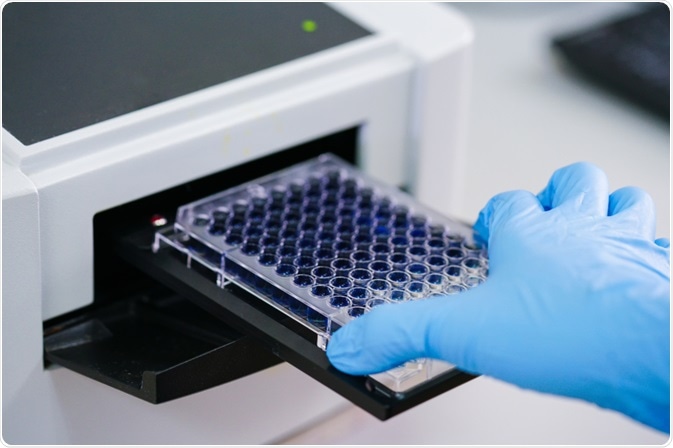Enzyme-Linked Immunosorbent Assay (ELISA) is an immunological technique used for detecting and measuring specific proteins, such as antibodies, antigens, and hormones in biological samples.

Choksawatdikorn | Shutterstock
How does ELISA work?
ELISA is based on specific antigen-antibody reaction and usually involves immobilizing antibodies or antigens to a 96-well or 384-well plate. The basic steps of ELISA:
- Immobilization of the target proteins/antigens on the surface of a microplate
- Washing unbound/excess proteins/antigens from the plate
- Adding a labeled antibody which will subsequently bind the target antigen/protein present in the plate
- Washing unbound (excess) antibodies off the plate
- Adding enzyme-specific substrates that will react with the enzyme and produce a colored product, which can be measured colorimetrically using a microplate reader.
Horse radish peroxidase (HRP) or alkaline phosphatase are common enzymes used in ELISA, while substrates include tetramethylbenzidine (TMB) and 2, 2′-azino-bis-3-ethylbenzthiazoline-6-sulphonic acid (ABTS). Duplicate or triplicate sampling is generally preferred and different concentrations of the sample are used to ensure biologically acceptable range of detection.
Standard curve
To quantify the concentration of target antigen, a standard curve is generated using known concentrations of the antigen. Next, the optical density (light absorption of the enzyme-substrate reaction product) obtained from the colorimetric assay is plotted on the standard curve to accurately measure the level of target antigen in the biological sample.
Types of ELISA
Direct ELISA
A target protein/antigen is immobilized on the plate surface and then an enzyme-labeled antibody raised against the target molecule is added.
Colorimetric detection is performed after addition of a suitable substrate. This format is easy and less time consuming. However, there is high experimental background due to binding of all target antigens to the surface, in addition to difficulties with primary antibody labeling.
Indirect ELISA
A target protein/antigen immobilized on the plate surface is incubated with a primary antibody that is raised against the target molecule. Then, an enzyme-labeled secondary antibody generated against the primary antibody is used for the detection and quantification. Although this format is more sensitive than direct ELISA, there is high false-positive detection due to secondary antibody cross.
Sandwich ELISA
Two antibodies (capture antibody and detection antibody) raised against different epitopes (a specific antibody-binding site of an antigen) of a target protein/antigen are required for this ELISA format.
The procedure involves immobilizing antibody (capture antibody) raised against the target antigen in the microplate; adding biological sample containing target antigen into the plate, which will subsequently bind the immobilized antibody present in the plate; adding an enzyme-labeled antibody (detection antibody) which will subsequently bind to the target antigen present in the plate; and adding enzyme-specific substrates to the plate that will react with the enzyme and produce a colored product for detection. This format involves two antibodies detecting different epitopes of the target molecule making it very specific.
Competitive ELISA
In this procedure, a reference antigen is immobilized on the plate surface and biological sample pre-incubated with a specific amount of labeled antibody is added to the plate. The amount of antigen present in the sample will determine the amount of unbound or free antibodies available for binding the reference antigen in the plate. This format is particularly suitable for targets with low molecular weight.
Enzyme-Linked Immunosorbent Assay (ELISA) - Multi-Lingual Captions
What are the advantages of ELISA?
The main advantage of ELISA is high sensitivity and specificity, suitable for detecting target molecules even at pictogram levels. It is frequently used for high-throughput screening because of the easy and less demanding experimental procedures.
ELISA can also be used to quantify target molecules in a variety of samples, including serum, plasma, urine, saliva, cell or tissue extracts, etc.
What are the disadvantages of ELISA?
Since quantification is based on enzyme-substrate reaction, the time frame for detection is very short. In addition, only a limited amount of information such as presence or amount of a target molecule can be obtained through ELISA. Information related to the activity of a molecule cannot be obtained by this technique.
Further Reading
Last Updated: Dec 19, 2019